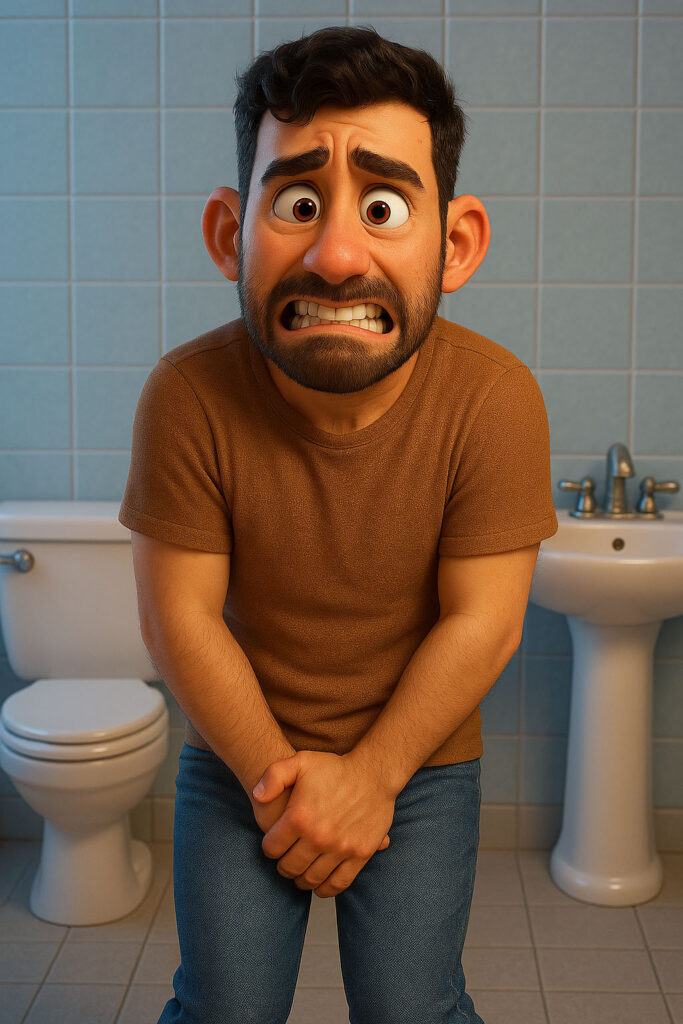Let’s talk Prostatitis vs. Enlarged Prostate—or, as I like to call it, the Battle of the Bulging Glands.
Meet the Prostate — A Walnut with Dreams
Let’s start at the beginning. The prostate. It’s small, it’s shy, it’s shaped like a walnut, and it lives deep in the male pelvis, just hanging out below the bladder like it’s trying not to be noticed. But don’t let its size fool you—this little guy plays a big role in baby-making and, apparently, in later-life plot twists.
The prostate is responsible for producing a chunk of the fluid that makes up semen. Without it, things in the reproduction department would get, well… dry. Think of the prostate as a backstage crew member at a Broadway show—rarely seen, but absolutely essential for the performance.
But as men age, the prostate can become a bit of a drama queen. Two of the most common ways it acts up? Prostatitis and Benign Prostatic Hyperplasia (BPH), a.k.a. enlarged prostate. Sounds like the start of a buddy comedy, right? Except these two aren’t buddies—they’re more like that one roommate who always eats your leftovers and blames it on the dog.
What the Hell is Prostatitis?
Let’s start with prostatitis. It sounds like a fancy Italian dish, but don’t be fooled. No parmesan here, just pain, peeing problems, and possible pelvic chaos.
Prostatitis is an inflammation of the prostate. It can be caused by a bacterial infection—or, in many cases, by absolutely nothing at all. It’s like the phantom of the urological opera: nobody invited it, nobody knows how it got there, but oh boy does it make a scene.
Symptoms of Prostatitis:
- Pain or burning during urination (aka peeing fire)
- Frequent urination (especially at night, which is awesome for your REM cycle)
- Pain in the lower abdomen, groin, or lower back
- Pain in the perineum (the no man’s land between your scrotum and rectum—aka the “taint” for those of us fluent in locker-room linguistics)
- Painful ejaculation (because why not ruin everything?)
There are four types of prostatitis, and if that feels excessive, welcome to the medical field. Everything needs subcategories. Here’s the Ryan Reynolds-style crash course:
- Acute bacterial prostatitis – The Michael Bay version: loud, sudden, dramatic, and needs emergency care.
- Chronic bacterial prostatitis – The clingy ex of infections. Keeps coming back, never texts before showing up.
- Chronic prostatitis/chronic pelvic pain syndrome (CP/CPPS) – The most common and least understood. Often, there’s no bacteria—just vibes.
- Asymptomatic inflammatory prostatitis – It’s there, you just don’t feel it. Like a bad sequel.
Enlarged Prostate — When the Walnut Becomes a Coconut
Now, let’s talk Benign Prostatic Hyperplasia, or BPH, which sounds like a corporation trying to ruin your weekend. BPH is the non-cancerous enlargement of the prostate. Keyword: non-cancerous. So, if you were holding your breath, you can breathe. Preferably into a paper bag if you’re still nervous.
BPH is like your prostate just… hitting middle age and deciding it wants to take up more space. Maybe buy a boat. Maybe get a hot tub. It’s not trying to hurt you—it’s just growing. Slowly. Stubbornly. Like your dad’s vinyl collection.
Symptoms of BPH:
- A weak urine stream (dribbling like an old faucet)
- Feeling like you have to pee all the time
- Trouble starting a stream (stage fright, but for your bladder)
- The annoying “I just peed, why do I have to pee again?” sensation
- Getting up several times at night to pee—welcome to the 3 a.m. bathroom club
Unlike prostatitis, BPH is about mechanics, not inflammation. The enlarged prostate presses on the urethra (that tiny tube that carries pee from the bladder), making it harder for the urine to flow freely. It’s like someone squeezing the middle of a toothpaste tube and expecting things to work smoothly.
Key Differences — Who’s Who in the Prostate Zoo?
Alright, let’s pit these two against each other, head-to-head:
| Feature | Prostatitis | BPH (Enlarged Prostate) |
|---|---|---|
| Age Group | Can affect men of any age, often younger men | Typically affects men over 50 |
| Cause | Often bacterial infection or unknown | Aging and hormonal changes |
| Pain? | Yes, usually painful | Rarely painful |
| Urinary Symptoms | Yes | Yes |
| Fever/Chills? | In acute bacterial prostatitis, yes | No |
| Treatable with Antibiotics? | Sometimes, if bacterial | Nope |
| Chronic? | Can be | Yes, but manageable |
| Cancer Risk? | No, but symptoms can mimic cancer | No, but needs monitoring |
In short, prostatitis is the angry, unpredictable houseguest, while BPH is your old uncle slowly expanding his recliner into the middle of the living room.
Prostatitis / BPH Diagnosis — The Doctor Will See You Now (and Yes, It Involves a Finger)
Whether it’s prostatitis or BPH, the path to diagnosis often involves:
- A digital rectal exam (yes, that’s doctor-speak for finger up the butt—don’t worry, they went to school for this)
- Urine tests to check for infection
- Blood tests to look for PSA (prostate-specific antigen), which can go up in both BPH and prostatitis
- Imaging like ultrasound or MRI, if needed
- Urodynamic tests, which sound fancy but basically check how well you pee
It’s not the most glamorous day at the doctor’s office, but hey—neither is kidney failure, and this is about staying ahead of the game.
Prostatitis / BPH Treatment – Less Drama, More Peeing
Let’s fix these issues, shall we?
Prostatitis:
- Antibiotics (if bacterial)
- Anti-inflammatory medications
- Alpha blockers (relax muscles around the bladder and prostate)
- Pain management (because, ouch)
- Pelvic floor therapy (yes, that’s a thing—strong pelvic muscles for the win)
- Sitz baths (basically soaking your butt in warm water—oddly comforting)
BPH:
- Lifestyle changes (less caffeine, alcohol, and late-night chugging of water)
- Medications like:
- Alpha blockers (again, muscle relaxers)
- 5-alpha reductase inhibitors (they shrink the prostate—it’s like sending it to the gym)
- Minimally invasive procedures (lasers, microwaves, radio waves—it’s like Star Wars down there)
- Surgery, if it gets really serious (TURP—transurethral resection of the prostate—is the gold standard)
Bottom line: both conditions are manageable. The key is not waiting until you’re peeing in Morse code to see a doctor.

Let’s Get Real – Mental Health and the Pee Game
Here’s the part most articles skip: mental health. Chronic prostatitis especially can be a real jerk to your mental state. Constant pain, interrupted sleep, and sexual dysfunction can lead to depression, anxiety, and a whole cocktail of “I just don’t feel like myself.”
It’s okay to talk about it. In fact, it’s necessary. Whether it’s therapy, support groups, or just venting to a friend (preferably one who won’t make a joke every five seconds, unlike yours truly), you don’t have to carry it alone.
Final Thoughts – You and Your Prostate: A Love Story
So here we are. You’ve learned that your prostate, while small and unassuming, is the dramatic arts major of your body. It thrives on attention and loves a good flair-up.
Prostatitis is the inflamed, irritated rebel yelling, “You can’t tell me what to do!”
BPH is the dad in cargo shorts who just wants to sit in peace but accidentally blocks the bathroom door.
They’re different. But they both deserve attention, care, and the occasional finger (by a licensed professional, thank you).
Here’s the takeaway:
- Don’t ignore urinary symptoms.
- Don’t self-diagnose with Google.
- Don’t be embarrassed—literally every man has a prostate.
- Do talk to your doctor.
- Do take care of yourself—mind and body.
And hey, maybe this wasn’t the sexiest topic on the planet—but if you’ve made it this far, give yourself a high five. You just became the most prostate-knowledgeable person in your friend group.
Now go forth and pee freely, my dude. 🕺💧
Best
Al
PS Want to add to the conversation? Leave a comment below!
